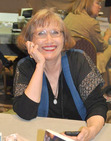Meg Benjamin's Blog, page 7
June 3, 2016
Running On Empty: Going For It
 Last year at this time I was a happy camper. The first book in the Salt Box Trilogy, Finding Mr. Right Now, had just been published. The second, Love In the Morning, had a publication date, and the third, Running On Empty, had been contracted. My first books set in Colorado had become a reality. In January 2016, Love In the Morning was published with good reviews (currently it has a 4.6 star average on Amazon), and I signed the contract for Running On Empty. Everything was looking rosy.
Last year at this time I was a happy camper. The first book in the Salt Box Trilogy, Finding Mr. Right Now, had just been published. The second, Love In the Morning, had a publication date, and the third, Running On Empty, had been contracted. My first books set in Colorado had become a reality. In January 2016, Love In the Morning was published with good reviews (currently it has a 4.6 star average on Amazon), and I signed the contract for Running On Empty. Everything was looking rosy.
Of course, that was then.
Earlier this year, Samhain Publishing, which bought my very first book, Venus In Blue Jeans, and kept me going with the entire Konigsburg saga, announced that they were closing down. Like most of Samhain’s authors I was upset by the news. I knew many of the people who worked for Samhain, as well as many of its authors—they were a very talented bunch, and I was sad to see them go.
But Samhain’s closure also had a more immediate effect for me personally. It meant that Running On Empty was no longer scheduled for publication since it hadn’t been edited or given a cover at the time the closure was announced. I had a few choices for the future of Running On Empty. First, I could have tried to find another publisher, but the chances of anyone wanting to take on the third book in a trilogy where the other two books belonged to Samhain were slim at best. I could have let it go, leaving the last book of the trilogy up in the air, but I didn’t want to do that.
My third choice—and the one I decided to go with—was publishing the book myself. Gleep!
Self publishing (the industry term is “indie” publishing) is an increasingly widespread phenomenon. An entire industry has sprung up over the last five years for authors who want to bring out their own, professionally produced books, including cover artists, editors, and formatters. I’d already had a little experience in self publishing when I took part in the Sapphire Falls Kindle World series with Going Up In Flames.
I needed to get my publication rights back from Samhain, but that didn’t prove to be a problem. Since they wouldn’t be publishing the book themselves, they were perfectly willing to give me back the contract. Rights in hand, I was ready to pursue an indie published version of Salt Box Trilogy, Book 3.
How hard could it be?
I’ll be pursuing the answer to that question over the rest of the summer, and talking about my experiences in this blog as I do it. All I can say for sure is this: Running On Empty will be coming out, probably in late August.
Stay tuned, gentle reader. Stay tuned.
May 19, 2016
Going Up In Flames
 Today is the release date for Going Up In Flames, my contribution to the Sapphire Falls Kindle World collection of novellas. Sapphire Falls is Erin Nicholas’s long-running series about a small town in central Nebraska. Several months ago, Erin asked me to be part of a Kindle World series centering around the Sapphire Falls summer town festival. I jumped at the chance to revisit some Konigsburg characters that I hadn’t been able to work into the full-length Konigsburg novels and to visit Erin’s lovely little town.
Today is the release date for Going Up In Flames, my contribution to the Sapphire Falls Kindle World collection of novellas. Sapphire Falls is Erin Nicholas’s long-running series about a small town in central Nebraska. Several months ago, Erin asked me to be part of a Kindle World series centering around the Sapphire Falls summer town festival. I jumped at the chance to revisit some Konigsburg characters that I hadn’t been able to work into the full-length Konigsburg novels and to visit Erin’s lovely little town.
In particular, I wanted to do something with Jorge Delgado, line cook extraordinaire, who was first glimpsed in Don’t Forget Me, and then went on to play small roles in Fearless Love and Hungry Heart. Jorge is one of those characters who’s always in the background, tickling your curiosity (or tickling mine, anyway). Brooding, mercurial, obviously someone with a temper. But also obviously someone who knows what he’s doing when it comes to cooking.
The idea of taking a purely Texas character (Jorge’s been known to wear a cowboy hat while cooking) and placing him in a purely Midwestern setting (Sapphire Falls is nothing if not Nebraska to the core) was just too good to pass up. I wanted Jorge to interact with someone who was similar to him in some ways but his total opposite in others. Enter my heroine, Kirsten Engstrom. She’s Sapphire Falls born and bred, but she’s also a cook with a longing to see the world beyond the borders of Nebraska. Here’s the blurb:
The chef is hotter than the barbecue sauce.
Jorge Delgado can cook anything, and this time around it’s barbecue. Running the Barbecue King’s food truck for the Sapphire Falls Town Festival should be a no-brainer, but his new assistant is a major distraction. She’s got him feeling some heat that doesn’t come from the firebox. And as if that weren’t enough, someone’s trying to sabotage his smoker and keep the people of Sapphire Falls from discovering the delights of Texas barbecue.
Kirsten Engstrom thought she was taking a temporary kitchen assistant job at her hometown festival. She didn’t know Texas barbecue came with a heaping helping of tasty chef. Now she’s dreaming of a future with a hot cook after the festival closes down—a future that can’t happen with one of them in Omaha and the other in the Texas Hill Country.
Can a couple of cooks beat the odds and stir up something sweet together? Maybe. But for now they’ve got a vandal to catch—and barbecue to cook.
And here’s a quick excerpt, what happens when you cross a couple of chefs with a hot Nebraska night:
She turned a corner toward an open field where some cars were parked, not the street where she’d been parked before.
He raised an eyebrow. “City parking lot?”
“Sapphire Falls style.” She paused next to her compact that had more than a few years and a few dents. “Here we are.”
He turned to face her. Reflected light from the street highlighted the slope of her cheekbones, the elegant shape of her nose. The rounded crescent of her lips. They edged up ever so slightly at the ends, like the shadow of a smile.
Almost without thinking about it, he leaned forward at the same time that she rose up on her toes.
Her lips were soft, yielding beneath his. He ran his tongue along the seam, then nibbled lightly. She opened for him on a sigh, and he let his tongue slide in, touching, tasting, enjoying. His hands moved to her hips, feeling the slight curves against his palms. He slowly pulled her closer until their bodies touched, knees to shoulders. Soft breasts caressed his chest. The swell of his arousal was achingly obvious.
Her hands moved along his arms to his shoulders and then looped behind his neck. Her hips moved against his, and heat flowed through his muscles like molten steel. He let his lips drift to the side of her throat, following the beat of her pulse to the dip at the center of her collarbones. She moaned, the sound moving through his body like quicksilver. Even the air around him seemed to vibrate with the sounds of arousal.
His body was on fire. His brain was mush. All he could think of was finding a horizontal surface as soon as possible. He pulled back slightly, eyes dazed, ready to go to the next level as soon as they could find a flat space.
And heard the sound of laughter coming from the street nearby. Very nearby.
Fuck. Just fuck. He moved back a step, catching his breath.
Kirsten stared up at him. Her eyes were slightly dazed too, but like him she was coming back to her senses. Quickly. “Wow,” she murmured.
He nodded. Wow summed it up nicely. Still want to go home? Want to hear some alternatives? He couldn’t for the life of him think of a way to ask that didn’t make him sound as scummy as the guy in the funnel cake stand.
“Well, I guess I’d better get home.” She gave him a quick, slightly nervous smile.
He leaned forward, sliding one arm around her waist, and kissed her again, putting everything he had into it—all the passion he could give. And then he pulled back. “Good night, Kirsten.”
She stared up at him again, touching her lips with her fingertips as she caught her breath. “Good night, Jorge,” she whispered. “See you tomorrow.” She turned and unlocked her car, sliding into the driver’s seat.
He watched her drive away, trying to decide if he’d been an idiot or not. On the whole, he thought not. Good night, Kirsten. And yeah, you most definitely will see me tomorrow.
Going Up In Flames, along with eleven other Sapphire Falls novellas by some wonderful authors, is now available on the Sapphire Falls Kindle World page.
April 20, 2016
The K Word
 So I have a new book coming out on May 17, Going Up In Flames. It’s a novella, part of the Kindle World series for Erin Nicholas’s Sapphire Falls books. This book has been a lot of fun to work with and a kind of lifesaver in the midst of the chaos and uncertainty of Samhain’s shutdown. The hero is Jorge Delgado, a secondary character in all the Konigsburg books related to the Rose restaurant (Don’t Forget Me, Fearless Love, and most of all Hungry Heart). Jorge is running the Barbecue King’s food truck at the Sapphire Falls town festival and he falls for a local girl, Kirsten Engstrom.
So I have a new book coming out on May 17, Going Up In Flames. It’s a novella, part of the Kindle World series for Erin Nicholas’s Sapphire Falls books. This book has been a lot of fun to work with and a kind of lifesaver in the midst of the chaos and uncertainty of Samhain’s shutdown. The hero is Jorge Delgado, a secondary character in all the Konigsburg books related to the Rose restaurant (Don’t Forget Me, Fearless Love, and most of all Hungry Heart). Jorge is running the Barbecue King’s food truck at the Sapphire Falls town festival and he falls for a local girl, Kirsten Engstrom.
I’ll tell you all more about Going Up In Flames as the release gets closer, but here’s the rub: I can’t call it a Konigsburg book. In fact, I can’t even mention the name Konigsburg in the story. According to Amazon’s legal department, while I own the names of my characters (the Barbecue King is safe), I don’t own the place names. Thus if I use the name Konigsburg in the book, Erin could claim it and I’d never be able to write another Konigsburg book.
Now I’d like to emphasize that Erin has no intention of claiming Konigsburg. In fact, she’s said so expressly and has said she’s willing to sign a legal waiver to that effect. Doesn’t mater, says the legal department. Her descendants could claim Konigsburg because I used it in a Sapphire Falls Kindle World, which would mean my descendants would lose the right to write more Konigsburg books. Leaving aside for the moment the extreme unlikeliness of my sons ever wanting to write a Konigsburg novel or Erin’s kids wanting to do the same, Amazon is still adamant about not using the name Konigsburg in the book.
So what to do? One of my reasons for writing Going Up In Flames was the hope that it might interest new readers in the Konigsburg universe since I hope to go on writing books set there (probably under my own independent label). Avoiding any mention of Konigsburg seems counterproductive to me, but using the name in the book risks the ire of Amazon (not something I want to do).
The solution came from my hubs. “Call it K-burg,” he suggested. Which is what I did. If Erin’s grandchildren want to write K-burg books, they have my permission.
It’s far from an ideal solution, of course. I can imagine readers going “K-burg? What the hell is K-burg?” I can only hope they’ll cruise over to my Web site and see all the references to Konigsburg, putting two and two together. And I hope they’ll love Jorge and Kirsten and the Barbecue King and Darcy because I hope they’ll all show up again in future books.
Here’s to Konigsburg. Long may it wave.
April 6, 2016
The Willing Suspension of Disbelief
 The willing suspension of disbelief was Samuel Taylor Coleridge’s description of the interaction between readers and writing. In general, readers have to suspend their knowledge that they’re reading fiction. They have to enter into a kind of agreement with the writer to withhold any innate skepticism and allow the author to make her case.
The willing suspension of disbelief was Samuel Taylor Coleridge’s description of the interaction between readers and writing. In general, readers have to suspend their knowledge that they’re reading fiction. They have to enter into a kind of agreement with the writer to withhold any innate skepticism and allow the author to make her case.
It’s easy to see how this idea works out in fantasy. The reader agrees to accept a world in which vampires or werewolves exist. In turn, the writer agrees to provide a world in which these creatures can function. Win/win, right?
But what about works that aren’t fantasy. Do happy endings require willing suspension of disbelief? Sometimes. Particularly if either the hero or heroine has character flaws that make you doubt their ability to function in the long term. But if you like the characters, you’re usually willing to overlook their problems and hope for the best.
To me, the more troubling situation comes when the author has created a premise that requires the reader to ignore some basic realities. I ran into that situation lately in a suspense thriller.
Now thrillers have their own set of standard premises. For example, you frequently have to accept the idea that there are lots of serial killers out there, and that they’re all fiendishly clever in the tradition of Hannibal Lector. If the author is skillful enough (e.g., Tess Gerritsen), you’re willing to overlook the unlikeliness of this situation and allow her to weave her plot without asking uncomfortable questions. The problem comes when those questions intrude anyway. The thriller I was reading depended on the idea that a brilliant psychiatrist was setting up a special prison-and-treatment-center for psychopaths. She was collecting these psychopaths from prisons around the country and building her center in a remote corner of the US to enable a corps of psychiatric professionals to perform long-range studies.
I was ready to buy in at first. Until the psychiatrist heroine arrived at a prison to interview one of her potential subjects. But then I found myself thinking “Are these state prisoners?” Which led to, “How is she able to take care of all the various jurisdictions?” Other objections began to occur to me. Were there really that many violent psychopathic killers who weren’t on death row? Given that traditional psychiatry has been under attack for a while, how many states would really buy into an idea like that? And, most of all, where the hell would the funding come from?
At that point, of course, I was way outside the story. And the fact that the heroine was being stalked by, you guessed it, a psychopathic serial killer was another problem.
And that’s the real risk with the willing suspension of disbelief. Once you lose it, it’s hard to get it back. I found it difficult, if not impossible, to crawl back into the story and let the author get on with it.
Most popular fiction is based on premises outside reality, and much of the time readers are willing to buy in. But if one little crack shows up in the world the author is building, the result may be total collapse. After all, you’re asking your readers for faith. And faith requires a strong foundation.
March 9, 2016
The Boring Psychopath
 So I just finished reading a book about a serial killer. Sigh. There are a lot of books about serial killers out there. In fact, there may be more books about serial killers than there are actual serial killers. The attraction of these villains is obvious—they give an author license to come up with particularly fiendish kinds of murders without having to really work with motives. The serial killer kills because he can, and because he likes it (there are, of course, female serial killers, but there are fewer of them, both in reality and fiction).
So I just finished reading a book about a serial killer. Sigh. There are a lot of books about serial killers out there. In fact, there may be more books about serial killers than there are actual serial killers. The attraction of these villains is obvious—they give an author license to come up with particularly fiendish kinds of murders without having to really work with motives. The serial killer kills because he can, and because he likes it (there are, of course, female serial killers, but there are fewer of them, both in reality and fiction).
In the hands of a skillful writer like Tess Gerritsen or Karen Rose, the serial killer can be both terrifying and oddly compelling. He represents an ultimate threat to the heroine (usually) or the hero (occasionally). Because the serial killer has no particular motivation, he can’t always be anticipated—the detective works on patterns of behavior rather than on any clearcut reasoning on the killer’s part. The killer may in fact be fiendishly clever (post-Hannibal, most of them are), but he’s still not rational. He’s killing for a sexual or psychological thrill, not because he has any kind of coherent plan.
Which is why he’s frequently a bore. I know I’m in the minority here, but I’m just not that into serial killers. Motivation is a great attraction in traditional mysteries and thrillers—why is something happening? What’s behind this murder or set of murders? It’s what animates detectives from Sherlock Holmes to Nero Wolfe. Trying to figure out just what’s going on is fun. But it’s also tough. Devising a plot where the killer kills because of something he needs or because of some quirk in the story is challenging.
Think about what happens when there’s a murder in the “real world.” The first thing we want to know is why. Why did the murderer do it? Was it planned or impulse? Did the murderer and victim know each other? Was there some kind of situation that led to this particular act? Even in this horrific age of mass shootings, we still want to know why a tragedy happened. Was the killer motivated by politics? Did he have a grudge against those he killed? Was he trying to make some kind of insane point?
Motivation obsesses us. But the psychopathic serial killer found in a lot of contemporary thrillers has no motivation to speak of. He just likes killing people. His thinking goes into coming up with nasty ways to dispose of his victims. There is, I suppose, a sort of fascination in that. But it’s not a fascination that holds my interest for long.
So I’ll go on reading serial killer thrillers, but I won’t seek them out. I’d rather spend time trying to unravel the clever plot. I may or may not buy in to the chain of evidence in the end. But at least I’ll have the fun of trying to figure it out.
February 17, 2016
The Petulant Heroine
 Female anger is a powerful thing. Think of all the social strictures that argue against it. Think of all the Facebook memes about it. Consider that there are actually expletives in English to describe an angry woman—shrew and bitch come immediately to mind. Given the wildly conflicting emotions female anger inspires, it’s an emotion that romance authors need to treat carefully but frequently don’t.
Female anger is a powerful thing. Think of all the social strictures that argue against it. Think of all the Facebook memes about it. Consider that there are actually expletives in English to describe an angry woman—shrew and bitch come immediately to mind. Given the wildly conflicting emotions female anger inspires, it’s an emotion that romance authors need to treat carefully but frequently don’t.
These observations were inspired by a recent read in which the hero and heroine were often at odds. They had a mutual quest, but they disagreed on the way to pursue it. At a certain point the hero insisted on carrying out a task alone despite the heroine’s demands that he take her with him. The heroine reacted by throwing a fit.
But here’s the thing—at that point in the story, the heroine had yet to demonstrate any competence in the tasks they’d undertaken. In fact, she’d had to be rescued a couple of times. The hero, in other words, was quite right to see her as more burden than help. The heroine’s hissy fit was a tantrum, and her anger was petulance. She hadn’t yet earned the right to be genuinely angry.
Now let me be very clear about my point here. I am not saying that women don’t have the right to be angry. Given the number of insults women have to endure regularly it would be a miracle if we weren’t. I am saying that all characters—both men and women—need to be angry for a good reason. Characters who get angry over trifles or who fly off the handle constantly are likely to be regarded as either unhinged or stupid. And you definitely don’t want a heroine being regarded as either. Heroines who become angry over justifiable things, however, can seem even stronger. They paid their dues, and they have a right to their fury.
Let’s put this in the context of the story I described above. Let’s say that instead of needing a rescue, the heroine rescued herself or—even better—rescued the hero. Or let’s say that while she began as unskilled and helpless, she quickly picked up skills as she went along and started to use those skills in ways that helped the couple in their quest. In either of these cases, the heroine would have a right to expect that she’d play a part in future adventures. And in either of these cases, the heroine would be fully justified in feeling honest anger at being excluded.
If the heroine earns her anger, readers will be fully on her side—right where you want them to be. And the hero will have to wise up if he expects to win her—and their—regard again. But when the heroine is just throwing a tantrum without adequate motive, the readers are likely to be more annoyed than sympathetic.
And annoyed readers are likely to do the worst thing an author can envision: close the book.
February 3, 2016
NaNoWriMo and Me
 National Novel Writing Month (NaNoWriMo) takes place each November. The idea is for participants to write a fifty-thousand-word novel by the end of the month, posting their totals every day and perhaps taking part in events such as online writing “sprints” in which they write nonstop for short periods.
National Novel Writing Month (NaNoWriMo) takes place each November. The idea is for participants to write a fifty-thousand-word novel by the end of the month, posting their totals every day and perhaps taking part in events such as online writing “sprints” in which they write nonstop for short periods.
I’d never taken part in NaNoWriMo myself. I didn’t entirely understand the concept behind it, and the goal of writing quickly didn’t really appeal to me. I wrote at my own pace, and it seemed adequate. But during the last year I began to feel unhappy with the amount of writing I’d been able to produce. And I wasn’t that delighted with the things I’d been writing. I felt like I was in danger of drifting into the eternal revision loop. So I signed up for NaNoWriMo to force myself to get moving.
And it worked. In fact, it more than worked: it set me in a new direction altogether. Before NaNoWriMo my minimum word count was a thousand per day. That’s not bad or unusual. A lot of working writers do a thousand a day, and some do less. But I felt stuck at a thousand, and I also felt I wasn’t accomplishing as much as I wanted. During NaNoWriMo, I pushed my daily total to two to three thousand. One amazing day I even managed to do four. And every day I’d post my total on my NaNoWriMo page and check what my friends had been able to do (you can link to friends who are also doing the challenge), and it felt really, really good. Since NaNoWriMo I’ve been able to keep that two-thousand-word average, and I know now that I could do more if I needed to. It’s surprisingly empowering knowledge. I came out of NaNoWriMo feeling re-energized and optimistic. And I had a new Konigsburg novella to show for it.
Every year there are a series of blog posts from professional writers criticizing NaNoWriMo. They make several points, but those boil down to a couple of major ones. First, writing fifty thousand words doesn’t mean you’re a writer, it just means you wrote fifty thousand words in a month. Which leads to the second point: there’s no guarantee that those fifty thousand words aren’t total crap. This is undoubtedly true. Doing NaNoWriMo doesn’t guarantee that you’ll be a writer when you finish. Becoming a writer takes long hours of critiques and revision and learning your craft. But I’d argue that being able to produce a finished work is the necessary first step in this process. How many people say they want to write a book and never do? While it’s true that some of those people probably shouldn’t be writing books in the first place, even those who should haven’t been able to. And NaNoWriMo shows them that they can, if they’re willing to put in the time.
So I’ll probably do NaNoWriMo again next year just for the fun of it. And from now on I’ll be properly supportive of other people who sign up, whether they finish or not. After all, challenging yourself is always a good idea. Right?
January 8, 2016
New Website!
As you can see, there’s a brand new design here at MegBenjamin.com! Feel free to look around and learn more about me and my books! Even better, my site and my blog have been integrated into one united space, so now it’s a one-stop-shop for all things Meg. Click on the home page images to get right to the featured pages and keep track of all social media posts at the bottom of every page. From now on, you’ll never miss a beat!
So what do you think? Is there anything you’d like to see here? Share your thoughts!
December 2, 2015
Love in the Morning Ready for Preorder
 When you’re writing a series, book 2 is often easier than book 1. In book 1, you’re getting used to the place and its people. The process is full of interesting discoveries, but it’s also time consuming. You’re constantly asking yourself if you want to go there or if you want to go there. People appear and take shape, and sometimes you have to toss them out and try again. It’s sort of like coming to a new town for the first time and finding your way. In fact, it’s exactly like that.
When you’re writing a series, book 2 is often easier than book 1. In book 1, you’re getting used to the place and its people. The process is full of interesting discoveries, but it’s also time consuming. You’re constantly asking yourself if you want to go there or if you want to go there. People appear and take shape, and sometimes you have to toss them out and try again. It’s sort of like coming to a new town for the first time and finding your way. In fact, it’s exactly like that.
But by book 2, you feel at home. The discovery process is over, and now you can settle in and have fun. That’s what happened with Love in the Morning, book 2 in the Salt Box Trilogy. Book 1, Finding Mr. Right Now, was largely in the point of view of people who were visiting Salt Box for the first time. They were learning about places like the Praeger House hotel and the Blarney Stone bar nearby. And they were getting to know the town’s somewhat quirky residents. In Love in the Morning, you have the point of view of one outsider—Lizzy Apodaca—and one long-time resident—Clark Denham. And since Lizzy is the new head chef at the Praeger House, she becomes an insider a lot more quickly than the characters in Finding Mr. Right Now.
It’s always fun to write from the point of view of someone who knows what’s going on, and in this case it was even more fun because Lizzy’s got a secret—a big one. While she’s learning about the town and its citizens, she’s doing her best to keep them from learning about her, at least for a while.
There’s also a reality show causing problems for everyone, just as there was in Finding Mr. Right Now. And there’s a lot of food—one of my favorite things to write about.
You can preorder Love in the Morning now at Amazon, Barnes and Noble, Kobo, iTunes, and all the usual places. The book will be released on January 5. Here’s the blurb:
Love in the Morning
Breakfast with benefits…
The Salt Box Trilogy, Book 2
The reality show Lovely Ladies of L.A. should have launched Lizzy Apodaca’s catering company into solvency. Instead, when her carefully prepared appetizers mysteriously gave the cast on-camera food poisoning, she lost everything.
To make matters worse, her car breaks down in Salt Box, Colorado, a town not much bigger than a salt shaker. But maybe her luck is changing—the handsome owner of Praeger House, the town’s premier hotel, needs a kitchen assistant.
Clark Denham realizes his diamond in the rough is a polished gem when Lizzy steps up to save the hotel’s breakfast buffet after his temperamental head chef quits. It isn’t long before she’s winning his heart as smoothly and efficiently as she runs his kitchen.
Their relationship goes from simmer to rolling boil with the speed of a short order cook. But when a bevy of not-so-lovely ladies shows up in Salt Box, Lizzy’s past disaster threatens to flatten her happily ever after faster than a falling soufflé.





